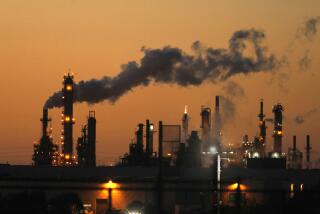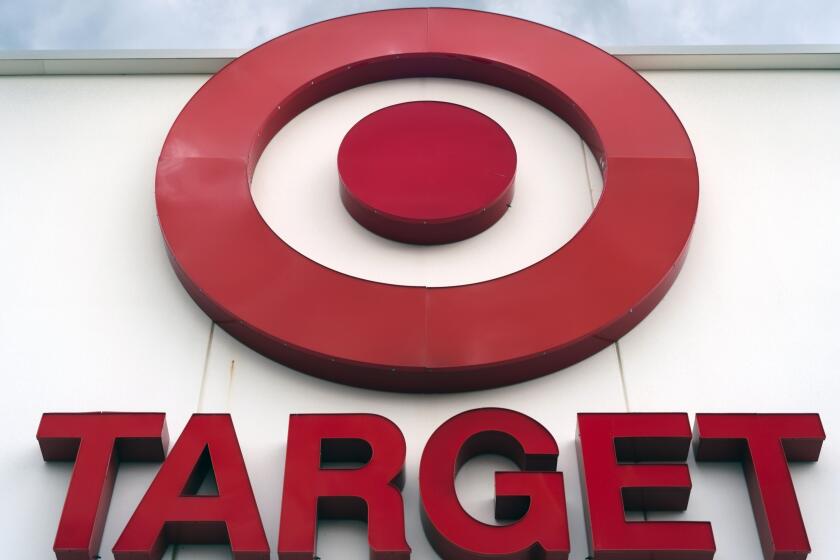Texaco Led Run-Up in Southland Gas Prices
- Share via
Texaco, a relatively small player in the Southern California gasoline market, led the surge in prices over the last two months with a steady drumbeat of increases, even though supplies and crude oil costs were falling and rising unevenly during the period.
According to a Times computer analysis of gasoline price data provided by the Lundberg Survey, an industry research firm, the five other major refiners in the city of Los Angeles chased Texaco, which had the highest prices during that time. No. 1 Arco lagged the others but ultimately raised prices the most.
The figures provide a rare behind-the-scenes glimpse at the way prices are set in the seemingly byzantine oil markets, and they raise possible issues for federal regulators investigating the reasons for the dramatic run-up in gasoline prices this spring.
Texaco’s moves illustrate how a single company’s aggressive marketing strategy can, in the short term, affect commodity prices as much as the laws of supply and demand or the price of the crude oil from which gasoline is made.
Texaco’s increases in the price it charged dealers for gasoline, and the subsequent moves by its competitors, were the principal factors in the rise of retail gasoline prices by more than 30 cents a gallon since January, to about $1.50 a gallon. Texaco’s major refining competitors in Los Angeles are Arco, Chevron, Mobil, Unocal and Shell.
Dealers pay the wholesale price, add taxes and set the ultimate pump prices by determining their own profit margin.
Texaco’s price hikes “reflect our perception of the market conditions affecting our different classes of trade,” said Philip W. Blackburn, Texaco’s spokesman for the Western Region, based in Universal City. “Our pricing reflects market conditions.”
The industry has maintained that the price run-up was due to statewide production and inventory constraints, the rising cost of crude oil and the higher cost of making cleaner burning gasoline.
But Texaco’s repeated price hikes occurred during a time when crude oil prices, gasoline inventories and gasoline production statewide were rising and falling inconsistently, according to a comparison with statewide data provided by the California Energy Commission.
And Texaco’s total price increases of 28.3 cents far exceeded the estimated 5 to 8 cents-per-gallon cost of producing new state-mandated cleaner burning gasolines, which began appearing at Texaco dealers the week ending March 15.
Given that, the consistency of Texaco’s weekly price increases raises the question of whether the refiner was testing the market to see if it would sustain a higher price. Texaco had the highest wholesale prices in eight out of 10 weeks surveyed.
“There’s no law . . . which prohibits one of these companies from saying, ‘Wait a minute: There’s a herd mentality out there. People are expecting us to raise our prices, so let’s do it,’ ” said Thomas Dove, a deputy attorney general for California, who prosecuted price-fixing cases involving refiners in the past. “They can raise prices, even without a supply-demand curve explanation.”
Nevertheless, he said: “If Texaco’s inventories were holding steady or climbing, it’s a damn good question to ask them: Why were they leading the charge up?”
Texaco’s Los Angeles refinery generally had steady production and inventories during this time, except for about a week of minor refinery problems at the end of March and the beginning of April that caused a brief dip in production, said Texaco spokeswoman Kelly McAndrew.
In addition to trying to make more money, refiners might raise prices for a number of legitimate reasons unrelated to the costs of making the gasoline or the supply-demand balance, analysts said. For example, to change its mix of gasoline grades to meet a changing market, a refiner might boost prices to build up inventory of a particular grade.
Starting in the week ending March 1, the price for Texaco-brand unleaded regular gasoline delivered to its dealers rose 2 cents a gallon every week for the next five weeks and was the highest in Los Angeles of any of the city’s six refiners during that time, the analysis showed. Its prices continued to rise through the end of April, including a 13-cent jump in the week ending April 19.
Texaco’s lead role in the price movement is all the more striking given its relatively small share of California’s retail gasoline market. Statewide, Texaco ranks ninth in gasoline sales, with about 5% of the market, behind all of the major refiners and such independents as Tosco. Market leader Arco has about 20% of the market, according to the State Board of Equalization.
The rest of the refiners eventually caught up with Texaco. By the end of April, the difference between the highest price (Texaco) and lowest (Arco) had narrowed from nearly 11 cents a gallon in February to 6 cents.
The price of Arco gasoline, which was the lowest in nine out of the 10 weeks surveyed, nevertheless rose the most during that time, by more than 33 cents a gallon, compared to Texaco’s 28.3 cents a gallon.
During that time, total statewide production of gasoline rose and fell several times, as did inventories.
In the latter part of April, the state’s gasoline supply was being constrained by production outages at several refineries around the state, most notably the Shell Martinez refinery, which remains partly shut down.
By the end of April, total gasoline production had declined about 7% and inventories had fallen 7.4% compared to the end of February, suggesting that demand had picked up substantially at the same time production was curtailed.
The average price of two grades of crude oil used by California refineries also rose and fell week to week. By the end of April, however, crude prices had risen nearly 18% from the end of February.
*
The Times analysis confirms testimony by California Energy Commission Chairman Charles Imbrecht that the bulk of the recent retail gasoline price increases occurred in that portion of the price controlled by refiners: the so-called refiners margin.
That margin marks the difference between the cost of crude oil used to manufacture gasoline and the wholesale price at which it is sold to marketers and service stations. It reflects both the refiners’ costs of making gasoline and their profit.
California’s gasoline prices have risen much faster than those in the rest of the nation.
Refiners have also blamed the California price hikes on accidents at state refineries, including the Arco plant in Carson in March and the Shell refinery in Martinez on April 1, which they said constricted supply at a time when new, cleaner-burning gasolines were required to come into the market.
Even so, “we noticed this as well: that a number of refineries had already begun to ratchet their prices up,” Imbrecht said. “There’s really no way to draw definitive judgments on this kind of stuff, other than to say they were able to increase prices without [losing customers], and it’s clear they continued to test that.”
Petroleum industry consultant Clay Warnock, a former vice president of marketing for Unocal, said: “All of the refiners have been acting very aggressively with their wholesale prices.”
Such hikes could be justified by an expectation of increasing demand later on, even if current supply and demand are in balance, added Warnock, who has worked as a consultant for Texaco.
“You have to look out over time and look at all the production scenarios, down time in refineries, inventory levels, and make sure you can serve your branded outlets,” he said. “If supply looks tight, then the wholesale price goes up. Otherwise you get drained.”
*
Arco Chairman Mike R. Bowlin said at the company’s annual meeting Monday that during the price run-up brought about by the 1990 Gulf War, Arco kept prices low and ran out of gasoline “almost immediately” as customers lined up to buy the cheapest gas in town.
This time, Bowlin said, Arco decided to “follow the market” on the theory that it would be less disruptive to consumers to pay higher prices but to have gasoline available than it would be to face gasoline shortages.
The computer analysis was conducted on data drawn from a survey of gasoline dealers and wholesalers in the city of Los Angeles and provided to The Times by the Lundberg Survey. The data represents the average wholesale price paid by dealers for unleaded regular gasoline delivered in the city of Los Angeles.
Staff writer Nancy Rivera Brooks contributed to this story.
(BEGIN TEXT OF INFOBOX / INFOGRAPHIC)
Priming the Pump
Texaco led the gasoline price surge by Los Angeles refiners in March and April. Chevron and Arco, the state’s biggest gasoline retailers, followed the trend, according to a Times computer analysis.
TEXACO LEADS THE WAY
Prices paid by dealer for unleaded regular gasoline in L.A.*
In dollars per gallon:
April 26, 1996: $0.98
* prices paid for week ending each date
PRICE BREAKDOWN
As the cost of crude and refining has jumped, dealers have cut their margins, sometimes to the point of taking a loss on a gallon of gas.
Components of total gasoline price, in dollars:
Dec. 1995
$1.15
Dealer Margin: 8.3
Refiner Margin: 21.3
Crude Cost: 40.3
Federal Excise Tax: 18.4
State Excise Tax: 18
Sales Tax: 8.5
April 1996
$1.47
Dealer Margin: -1.2
Refiner Margin: 46.4
Crude Cost: 54.7
Federal Excise Tax: 18.4
State Excise Tax: 18
Sales Tax: 10.9
Sources: Lundberg Survey, Cal. Energy Commission
More to Read
Inside the business of entertainment
The Wide Shot brings you news, analysis and insights on everything from streaming wars to production — and what it all means for the future.
You may occasionally receive promotional content from the Los Angeles Times.










